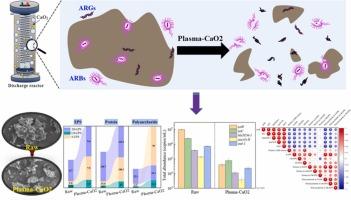血浆-过氧化钙联合处理污泥过程中污泥分解及抗生素抗性基因去除的协同效应
IF 11.3
1区 环境科学与生态学
Q1 ENGINEERING, ENVIRONMENTAL
引用次数: 0
摘要
废水处理过程中产生的多余污泥是抗生素耐药基因(ARGs)的主要储存库,构成环境和公共卫生风险。在本研究中,提出了一种等离子-过氧化钙(Plasma-CaO2)联合处理方法,同时促进污泥的分解和ARGs的去除。与单独处理相比,血浆- cao2显著改善了污泥的分解,表现为更高的分解率(9.7%),更显著地增加了乳酸脱氢酶(LDH)的释放(656.9%),更破碎的絮凝体。该处理还促进了细胞内和絮凝体嵌入有机物的释放,导致可溶性和紧密结合的细胞外聚合物(S-EPS和TB-EPS)的大量增加,其中S-EPS在反应过程中首先反应。除了污泥分解外,还观察到对ARGs去除的明显协同效应,特别是对tetW的去除效果为2.4 log。这种下降可能是由于ARGs释放到液体中,随后通过ROS进行氧化降解。ARGs与LDH、S-EPS呈显著负相关,进一步证实了污泥分解在促进ARGs去除中的作用。共现分析表明,burkholderaceae是blem -1、tetC和aac(3)-Ⅱ的潜在寄主。实验证明,1O2是驱动污泥分解和去除ARGs最关键的活性氧。综上所述,等离子体-过氧化氢联合系统在污泥预处理中提供了一种很有前途的策略。本文章由计算机程序翻译,如有差异,请以英文原文为准。

Synergistic effect on sludge disintegration and antibiotic resistance genes removal during sludge treatment by combined plasma-calcium peroxide
Excess sludge generated during wastewater treatment serves as a major reservoir of antibiotic resistance genes (ARGs), posing environmental and public health risks. In this study, a combined plasma-calcium peroxide (Plasma-CaO2) treatment was proposed to simultaneously enhance sludge disintegration and ARGs removal. Compared with solo treatment, Plasma-CaO2 significantly improved sludge disintegration, as evidenced by a higher disintegration rate (9.7%), more markedly increased lactate dehydrogenase (LDH) release (656.9%), and more fragmented flocs. The treatment also promoted the release of intracellular and floc-embedded organics, leading to substantial increases in soluble and tightly bound extracellular polymeric substances (S-EPS and TB-EPS), with S-EPS responding first during the reaction. Alongside with the sludge disintegration, an evident synergistic effect on ARGs removal was observed, particularly for tetW with a 2.4-log reduction. This decline might be attributed to the release of ARGs into liquid, followed by oxidative degradation via ROS. Significant negative correlations between ARGs and LDH, S-EPS further confirmed the role of sludge disintegration in facilitating ARGs removal. Co-occurrence analysis indicated family Burkholderiaceae as a potential host for blaTEM-1, tetC and aac(3)-Ⅱ. 1O2 was proven as the most critical ROS driving sludge disintegration and ARGs removal. Summarily, the combined Plasma-CaO2 system offers a promising strategy in sludge pre-treatment.
求助全文
通过发布文献求助,成功后即可免费获取论文全文。
去求助
来源期刊

Journal of Hazardous Materials
工程技术-工程:环境
CiteScore
25.40
自引率
5.90%
发文量
3059
审稿时长
58 days
期刊介绍:
The Journal of Hazardous Materials serves as a global platform for promoting cutting-edge research in the field of Environmental Science and Engineering. Our publication features a wide range of articles, including full-length research papers, review articles, and perspectives, with the aim of enhancing our understanding of the dangers and risks associated with various materials concerning public health and the environment. It is important to note that the term "environmental contaminants" refers specifically to substances that pose hazardous effects through contamination, while excluding those that do not have such impacts on the environment or human health. Moreover, we emphasize the distinction between wastes and hazardous materials in order to provide further clarity on the scope of the journal. We have a keen interest in exploring specific compounds and microbial agents that have adverse effects on the environment.
 求助内容:
求助内容: 应助结果提醒方式:
应助结果提醒方式:


